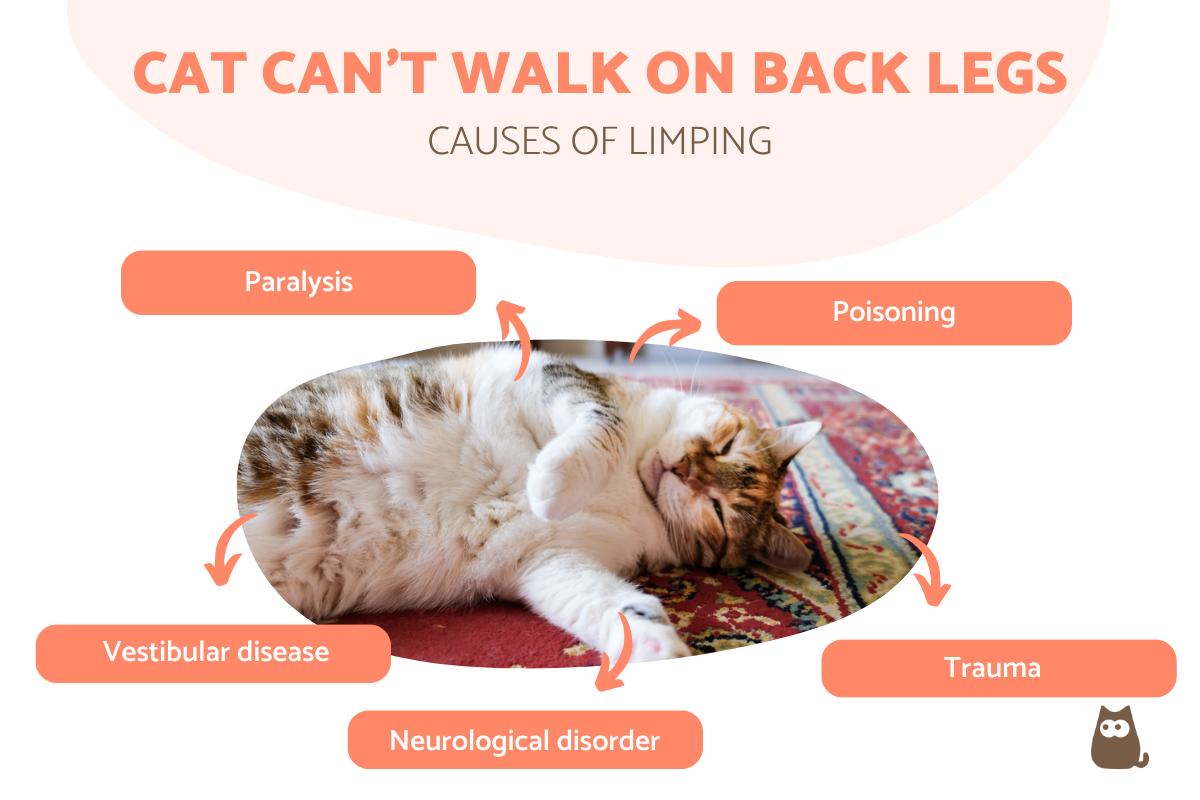My Cat Can’t Walk on Their Back Legs Properly



See files for Cats
If you have noticed your cat suddenly can't walk on their back legs, you will need to find out why. Some of the common causes that may explain why your cat can’t walk or why your cat is struggling to walk are very serious. If left untreated, we may risk permanent cat paralysis. This treatment is only possible to prescribe once the cause that prevents proper ambulation in cats is diagnosed.
Sometimes recovery may require surgery, hence the importance of veterinary consultation. In this way, if your cat walks weird or cannot walk at all, do not hesitate to consult a specialist. For more about why my cat can’t walk without falling over or why my cat can’t walk on his back legs properly, keep reading at AnimalWised.
My cat can’t walk on their back legs
Before we begin to explain the reasons why a cat can’t walk or stand, we need to pay attention to the characteristics of this impediment. The type of cat paralysis will help a vet diagnose the specific problem. A cat can suffer paralysis when it stops walking altogether. This problem is more common in the hind legs than the forelimbs and can completely prevent them from moving. Your cat will not be able to walk or even stand.
If your cat's back legs are collapsing, we see it happens more commonly in their hind legs. In these cases, the weakness is obvious. You may notice your cat try to stand, but falls or cannot move at all. When they do succeed in walking, they may make limping movements by raising the legs abnormally or the cat walks in circles. Other times, difficulty in mobility occurs because the cat is suffering from tremors, tics or convulsions throughout their body.
Paralysis in cats
The causes of cat paralysis can include an accident, being hit with something, a dog attack attack or a steep fall. This occurs when the spinal column is affected, impairing the nervous system’s communication with the legs. This interruption can cause immobility in your cat’s legs.
Although it may start as mild limping, these incidents can also cause life-threatening injuries, so going to a vet immediately is imperative. Make sure to always handle your cat with care in order not to worsen any injury.
In general, paralysis due to trauma means your cat will try to move as if unharmed. This is what leads to them limping on their back legs. It is also possible the paralysis is such that the cat drags their back legs behind their body. Again, it is much more common for limping or paralysis to occur on the hind legs rather than the front.
An x-ray or an MRI can give us information about the state of your cat’s vertebral column. Treatment will depend on the extent of the damage. Medication, rehabilitation or surgery may be required. A cat suffering from paralysis can recover or maintain sequelae, depending on the case’s specifics.
To prevent paralysis in cats, make sure your cat avoids open windows and does not have access to great heights. You can opt for placing mosquito nets on your windows to avoid falls.
Hypertrophic cardiomyopathy in cats
Hypertrophic cardiomyopathy can also cause paralysis in the legs of a cat, specifically targeting the hind legs and tail. Hypertrophic cardiomyopathy in cats occurs when the cat’s cardiovascular system fails and blood flow decreases. This usually results in the cat limping on their back legs. The severity will depend on the progression of the disease- For more, we recommend reading our article where we discuss heart failure in cats.
Cats can develop something known as high rise syndrome, a compulsion to climb to very high places from which they cannot come down. You can find more information in our video below where we show you how to stop cats climbing to places they shouldn't:

My cat can’t walk straight
There are numerous causes which can explain your cat is having trouble walking or standing. In older cats, you may notice that they stop climbing to heights. This is often a a sign of pain caused by a degenerative process such as osteoarthritis in cats which results in limping on any leg. If you believe your cat may be suffering a degenerative disease or has suffered trauma, take a look at our article where we find out how to tell if a cat is in pain.
Cats that have previously or are currently recovering from diseases such as feline panleukopenia (feline parvovirus) can also suffer from neurological sequelae that affect their walking. These cats will struggle to walk straight and lift their legs properly, giving them an abnormal gait and limping. If your cat loses balance easily or lacks coordination, this may be the reason why. These damages can be irreversible, but they may be able to live a happy life even with an impaired gait.
Vestibular disease in cats
Vestibular disease in cats is a neurological disorder in cats that produces symptoms such as:
- Head tilting
- Walking in circles
- Nystagmus (continuous eye movements)
- Strabismus
- Ataxia in cats, which produces the lack of coordination that will make it difficult to walk.
This syndrome can be caused by trauma, otitis in cats, infectious diseases and other processes. In order to identify the triggering cause, a neurological examination is required. Vestibular disease in cats can be treated, but some cats may be left with a permanently tilted head[1].
Finally, lack of balance in cats can also be caused by a cat ear infection. This will require veterinary consultation and is treated with antibiotics.
My cat can’t walk and won’t eat
Sometimes cats can’t walk on their back legs because they’ve lost control over their bodies. This makes them limp and fall over when trying to walk. This loss of body control can result from seizures in cats. These cause tremors or tics, sometimes accompanied by other symptoms. These cases are often caused by poisoning, which requires immediate veterinary attention. Prognosis in these cases depends on the substance which was ingested and the length of time after ingestion, as well as the age, breed and health status of the cat.
To avoid cat poisoning that causes seizures or tremors, you must prevent access to potentially toxic substances or plants for cats. Special care must be taken when it comes to anti-parasitic products for dogs. Although safe for canines, they sometimes include active ingredients which are toxic for cats.
If you know which substance has caused the cat poisoning, make sure to inform your veterinarian. With fluid therapy and medication, it is possible for your cat to reach recovery completely, although this depends on the prognosis[2].

My cat won’t walk on their front leg
You may have noticed your cat is limping on their front leg instead of their hindlimbs. Sometimes cats struggle to walk due to injury. If you suspect any localized damage to your cat’s paws, make sure to examine their fingers, nails and paw pads well. It could be something minor such as a splinter, but even these issues can be serious if complications such as secondary bacterial infections arise. If you notice any paw injury, contact your veterinarian.
These injuries can be serious and affect not only the paws. If they have fallen from height, sustained injuries in a fight or had a traffic collision, we might see the cat limping on their front leg. Cats are adept at hiding their pain, so we need to be very careful. Veterinary consultation is essential if we see limping.
To avoid paw injuries in cats, make sure that your cat doesn’t walk on hot surfaces. In addition, make sure your cat’s nails are always well maintained. We recommend establishing a routine where you check your cat’s paws and nails regularly. For more, take a look at our article where we discuss healing wounds on a cat’s paw pads.
Other reasons my cat can’t walk on one back leg
If your cat can't walk on their back legs and none of the previous causes correspond to their symptoms, there are other pathologies with limping as a clinical sign. Other causes of sudden paralysis in cats back legs include:
- Constipation
- Thrombosis
- A herniated disc
- Hip dysplasia
- Diabetes
- Cerebellar hyhoplasia
- Saddle thrombus (blood clots in cats)
- Tick paralysis
In all of the above cases, veterinary intervention is necessary. If you’re cat is struggling to walk and does not receive professional medical help, your cat’s life could be seriously compromised.
My kitten can’t walk all of a sudden
If your kitten can't walk on their back legs or stand, the above causes can be at fault. However, there are also some issues which affect kittens specifically, rather than adult cats. If our kitten can't walk, we should consider the possibility of fading kitten syndrome.
Especially when they are under 8 months of age, kittens are very fragile and susceptible to illness. If your kitten suddenly can’t walk, is lethargic and unresponsive, immediate veterinary attention is required.
Symptoms of fading kitten syndrome
- Difficulty breathing
- Trouble walking or standing
- Lethargy
- Excessive crying
- Pale or white gums
- Low body temperature
Causes of fading kittens syndrome
- Inadequate care and attention
- Trauma
- Hypothermia
- Bacterial infection
- Viral infections such as herpesvirus, feline AIDS, etc.
- Underdeveloped immunity
Treatment of fading kitten syndrome
If your kitten can’t walk or stand, take it to the veterinarian immediately. They will carry out the correct diagnostic tests to determine the underlying cause. We will need to provide supportive treatment while this diagnosis is being made. We should make sure the kitten is warm, has enough water and is offered an adequate high quality diet.
For more, we recommend taking a look at our article where we discuss how to care for kittens.

My old cat can’t walk on their back legs
Cats over the age of about 7 or 8 years become prone to conditions such as osteoarthritis. Arthritis in cats is very common in older cats and therefore cannot be ignored as a possible cause of why your senior cat can’t walk on their back legs. Other causes of older cats struggling to walk include the possibility of:
- Diabetes
- Nerve degeneration
- Hyperthyroidism
- Kidney disease
- Blindness
If your old cat can’t walk or stand, take it to the vet immediately. A professional will be able to diagnose the problem correctly and treat it accordingly.
This article is purely informative. AnimalWised does not have the authority to prescribe any veterinary treatment or create a diagnosis. We invite you to take your pet to the veterinarian if they are suffering from any condition or pain.
If you want to read similar articles to My Cat Can’t Walk on Their Back Legs Properly, we recommend you visit our Other health problems category.
1. Burke, E. E., Moise, N. S., de Lahunta, A., & Erb, H. N. (1985). Review of idiopathic feline vestibular syndrome in 75 cats. Journal of the American Veterinary Medical Association, 187(9), 941-943.
https://europepmc.org/abstract/med/4055520
2. Crismon, J. M., Crismon, C. S., Calabresi, M., & Darrow, D. C., (1943). Electrolyte Resdistribution in Cat Heart and Skeletal Muscle in Potassium Poisoning. The Journal of American Physiology, 139(5), 667-674.
https://www.physiology.org/doi/abs/10.1152/ajplegacy.1943.139.5.667?journalCode=ajplegacy







